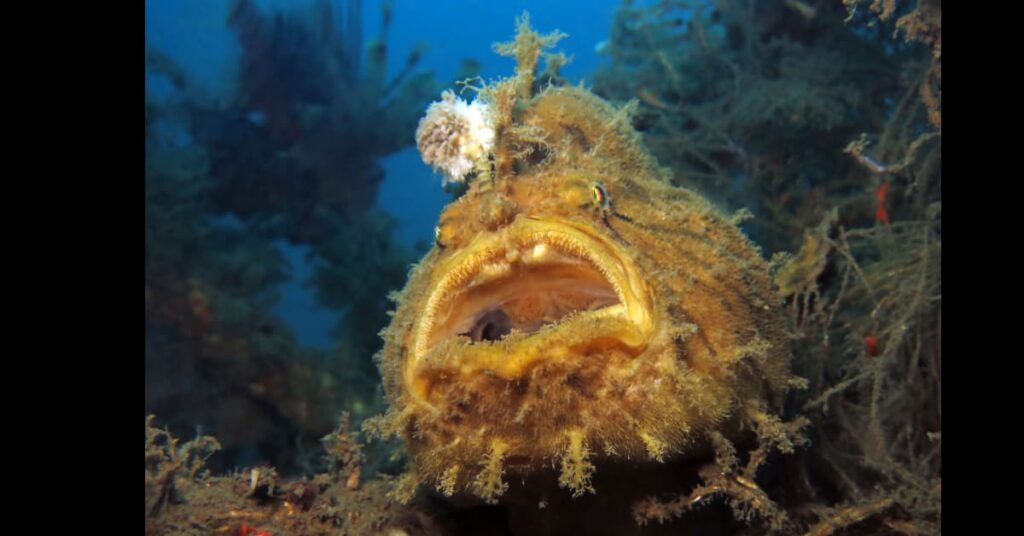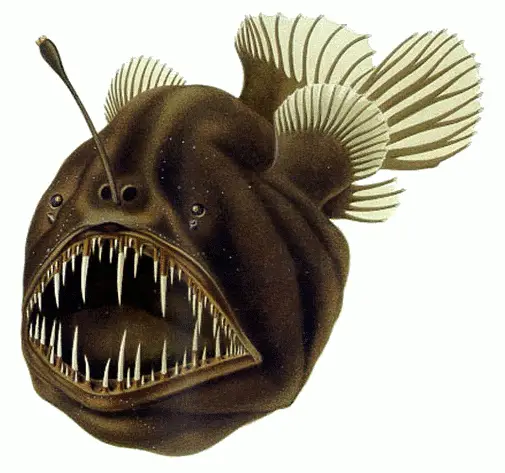Deep-sea anglerfish are some of the most fascinating creatures in the world. These mysterious fish are known for their unique appearance and bizarre hunting methods. Here are 12 fascinating facts about deep-sea anglerfish that will leave you in awe!
- Anglerfish are named after the way they hunt. These bony fish use a fleshy, glowing lure on top of their heads to attract prey in the dark depths of the ocean.
- The anglerfish’s lure is actually a modified dorsal fin. It contains bioluminescent bacteria that help to attract prey.
- The female anglerfish is much larger than the male. In fact, the male is so small that he will attach himself to the female and live off of her for the rest of his life.
- The male anglerfish has a specialized sense of smell that helps him find a female. Once he finds a female, he will bite her and then fuse his body to hers.
- Some species of anglerfish have bioluminescent bacteria that live in their stomachs. The bacteria help to break down food and also produce light, which the fish use to attract prey.
- Anglerfish have enormous crescent-shaped mouths that are filled with sharp, translucent teeth that can easily tear apart their prey.
- Anglerfish can swallow prey that is twice their size, and they have a flexible stomach that allows them to digest prey that is larger than their own body.
- Some species of anglerfish live up to 1,500 meters below the surface of the ocean. The pressure at these depths is over 100 times greater than at the surface.
- Anglerfish have such a slow metabolism that they can go weeks or even months without eating.
- Some species of anglerfish have transparent bodies that make them almost invisible in the water.
- The anglerfish’s glowing lure can also be used to ward off predators. When threatened, the fish can make the lure glow bright enough to startle its attacker.
- Anglerfish are not typically kept in captivity because they are difficult to care for and require very specific conditions. However, some aquariums have been able to successfully keep and display them.
How Do Anglerfish Attract Prey?
One of the most striking features of deep sea anglerfish is its bioluminescent lure. The lure is located on the end of a modified dorsal spine, called an illicium, and can be used to attract prey in the dark depths of the ocean.
Using a muscular skin flap, the anglerfish can either hide or reveal its lighted lure. By pulsing the light and moving the lure back and forth, they successfully attract pelagic crustaceans, fishes, and other prey.
The lure is filled with bacteria that make their own light, making it visible even in the darkest depths of the ocean. This unique adaptation allows the anglerfish to catch prey in an environment where food is scarce and competition is fierce.
Some species of anglerfish have a symbiotic relationship with bioluminescent bacteria that live in their lure and can provide a constant source of light.
Where do Deep Sea Anglerfish Live?
Deep sea anglerfish are a group of fish that are found in the deep sea, typically at depths of 1,000 meters or more. They are found in all of the world’s oceans, but are most commonly found in the Atlantic and Antarctic oceans.
There are over 200 species of anglerfish, each with their own unique adaptations to life in the deep sea.

Distinctive Features
Deep sea anglerfish are known for their unique appearance and many distinctive features. Some of these features include:
- Large mouths and expandable stomachs that allow them to swallow prey that is larger than their own body.
- Elongated, spiny fins that help them to maneuver in the water and avoid predators.
- Camouflaging skin that helps them blend in with their surroundings and avoid detection.
- A unique reproductive strategy where males are much smaller than females and will often fuse their bodies to the female in order to reproduce.
Overall, deep sea anglerfish are fascinating creatures that have adapted to life in one of the harshest environments on Earth. Their unique appearance and behavior make them a popular subject of study for scientists and a favorite of many ocean enthusiasts.
Habitat and Behavior
Deep-Sea Environment
Deep-sea anglerfish are a group of fish that inhabit the deep-sea environment, which is characterized by low temperatures, high pressure, and low light conditions.
These fish are found at depths of up to 1 mile below the ocean surface, where they have adapted to the harsh conditions of the deep, dark abyss.
Reproduction
One of the unique aspects of deep-sea anglerfish behavior is their reproductive strategy. The males of some species are much smaller than the females and possess sharp teeth, which they use to attach themselves to the females.
The males then become parasitic, relying on the female for sustenance and mating opportunities.
Diet and Prey
Deep-sea anglerfish are ambush predators, using their sharp teeth and bioluminescent lure to attract prey.
Their diet consists of a variety of pelagic crustaceans and fish, which they capture using their sharp teeth and powerful jaws.
Predation and Defense
Despite their sharp teeth and powerful jaws, deep-sea anglerfish are still vulnerable to predation. They have evolved a variety of defense mechanisms, including their bioluminescent lure, which they use to attract prey and confuse predators.
Some Fascinating Species of Deep Sea Anglerfish
There are over 200 known species of deep sea anglerfish, each with unique characteristics and adaptations that allow them to survive in their harsh environment. In this section, we will explore some of the most interesting species of deep sea anglerfish.
Melanocetus Johnsonii
Melanocetus johnsonii, also known as the Black Seadevil, is one of the most well-known species of deep sea anglerfish. This fish is known for its large head and mouth, which is lined with rows of sharp teeth.
The Black Seadevil has a long, bioluminescent lure on its head that it uses to attract prey. This species is found in the benthic zone of the ocean, at depths of up to 1,500 meters.
Ceratiidae
The Ceratiidae family of deep sea anglerfish includes some of the most bizarre-looking creatures in the ocean.
These fish have elongated bodies and fins, and the males are much smaller than the females. In some species, the males are so small that they are almost completely parasitic, attaching themselves to the females and living off their blood.
The Ceratiidae family includes the infamous Humpback Anglerfish, which has a crescent-shaped mouth and a bioluminescent lure on its head.
Cryptopsaras Couesii
Cryptopsaras couesii is a deep sea anglerfish that is known for its unique appearance. This fish has a large, bulbous head and a small body, with a long, thin tail.
The Cryptopsaras couesii has a bioluminescent lure on its head that it uses to attract prey. This species is found at depths of up to 1,200 meters.
Humpback Anglerfish
The Humpback Anglerfish is one of the most iconic species of deep sea anglerfish. This fish has a large head and mouth, with a crescent-shaped jaw that is lined with sharp teeth. The Humpback Anglerfish has a bioluminescent lure on its head that it uses to attract prey. This species is found in the benthic zone of the ocean, at depths of up to 1,600 meters.
Thanks to advances in technology, such as the ROVs developed by the Rebikoff-Niggeler Foundation, we are able to see footage of these amazing creatures in their natural habitat.

Amaze Your Friends! Tell Them About Anglerfish
OK, they might look ugly to us – but apparently not to a lonely anglerfish looking for a mate!
National Geographic has described the deep sea anglerfish as one of the ugliest animals on the planet, but their appearance is just one small part of their story. Researchers at the University of Washington have been studying these creatures for years, and they have discovered many interesting facts about them.
Deep sea anglerfish are known for their unique appearance, with a fishing pole-like appendage protruding from their heads, and their ability to attract prey with bioluminescent lures.
For example, E-Life reports that deep sea anglerfish are actually a family of fishes called goosefishes, and they can be found in oceans around the world. They are also incredibly adapted to their environment, with the ability to survive in the extreme pressures and temperatures of the deep sea.
Despite their unique adaptations, deep sea anglerfish are not immune to human activities. Overfishing, ocean acidification, and expanding low-oxygen zones in the ocean could wipe out key organisms and cause irreversible changes in deep-sea food webs, according to the Monterey Bay Aquarium.
Deep sea anglerfish play a crucial role in controlling the population of other species and are an indicator of the health of the ocean. Studying these fish can help us better understand the complex interactions between different species in the ocean and the impact of human activities on the marine environment.
References:
Anglerfish – Fish Facts: National Geographic – https://www.nationalgeographic.com/animals/fish/facts/anglerfish
Deep Sea Anglerfish: Monterey Bay Aquarium – https://www.montereybayaquarium.org/animals/animals-a-to-z/deep-sea-anglerfish/

